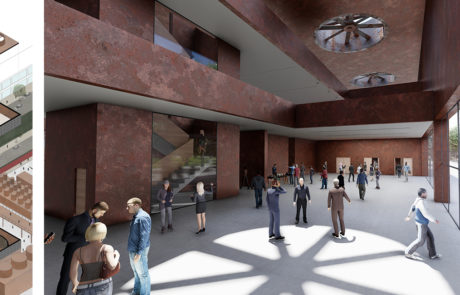Um Parque Atlântico

Autoria: Duarte Santos
Orientação: Nuno Grande
Co-Orientador:
Universidade de Coimbra - Faculdade de Ciências e Tecnologia
Memória descritiva
PROPOSTA PARA UMA NOVA PAISAGEM NA ÁREA PÓS-INDUSTIRAL DO CABO DO MUNDO
Este trabalho propõe a reconversão urbana e paisagística da Refinaria de Leça da Palmeira (Matosinhos) na perspetiva de uma cidade pós-industrial.
O principal objetivo desta reconversão é a incorporação do máximo de infreaestruturas existentes, a partir de uma intervenção mínima ou da reconversão das mesmas.
No trabalho de turma, desenvolveu-se um plano estratégico para a toda a área, em prol de uma intervenção sustentável, ao nível dos equipamentos e da residência.
O projeto decorreu em simultâneo com o advento da pandemia sanitária de 2020. Assim sendo, foram estudados temas como o co-housing, na perspetiva da possibilidade do isolamento individual, em articulação com a partilha coletiva, o transporte público sustentável, a agricultura urbana, e a introdução de energias renováveis.
O meu projeto individual, traduzido em dissertação de Mestrado, contemplou a reconversão da zona de produção da antiga refinaria num parque pós-industrial. O principal objetivo foi criar espaços que adaptem a imagem atual da refinaria, crua e inóspita, a um espaço qualificado e cosmopolita.
Para isso, recorreu-se à introdução, no seio do conjunto, de uma Mata Atlântica de pinheiros mansos, a qual preenche esses espaços, requalificando os percursos pedonais envolventes. Foram também reabilitadas duas infra-estruturas existentes: a primeira, uma instalação de refrigeração da central termoelétrica, transformada num pavilhão de exposições temporárias com uma sala de concertos; o segundo, uma torre industrial, transformada numa biblioteca e num pequeno café.
O Parque Atlântico é constituído por duas áreas: um conjunto de praças rodeadas pela maquinaria preexistente, agora reconvertida, onde se localizam os 3 edifícios reabilitados; a segunda, uma área de transição da zona industrial, com sequências de praias, dunas, pinhais, tal como ocorre noutras frentes de costa portuguesa. O objetivo principal da intervenção foi o de “renaturalizar” este aterro resultante das obras realizadas para a instalação do Porto de Leixões na década de de 1950.
AN ATLANTIC PARK
PROPOSAL FOR A NEW LANDSCAPE IN THE POSTINDUSTRIAL AREA OF CABO DO MUNDO, MATOSINHOS
This work suggests the urban and landscape reconversion of the Leça da Palmeira Refinery (Matosinhos) in the perspective of a post-industrial city. The main objective of this reconversion is the incorporation of as many existing infrastructures as possible, working with minimum intervention or leveraging their reconversion. In the class project, a strategic plan was developed for the whole area, favoring a sustainable intervention, in what concerns equipment and housing.
The project’s development took place simultaneously with the advent of the 2020 health pandemic. Therefore, topics such as co-housing were studied, from the perspective of the possibility of individual isolation, in conjunction with collective sharing, sustainable public transport, urban agriculture, and the introduction of renewable energies.
My individual project, which was became my master’s thesis, included the reconversion of the former refinery’s production area into a post-industrial park. The main goal was to create adaptable spaces the current landscape of the refinery, from raw and inhospitable to a qualified and cosmopolitan space.
To this end, an Atlantic Forest of stone pines was introduced within the complex, which fills these spaces, requalifying the surrounding footpaths. Two existing infrastructures were also rehabilitated: the first, a cooling installation for the thermoelectric power station, transformed into a pavilion for temporary exhibitions along with a concert hall; the second, an industrial tower, converted into a library and a small café.
The Atlantic Park consists of two areas: a set of squares surrounded by pre-existing machinery, now converted, where the three rehabilitations are located; the second, a transition area of the industrial zone, with sequences of beaches, dunes, pine forests, similarly to what occurs on other fronts along the Portuguese coast. The main objective of the intervention was to “renaturalize” the landfill resulting from the works carried out for the installation of the Port of Leixões in the 1950s.






